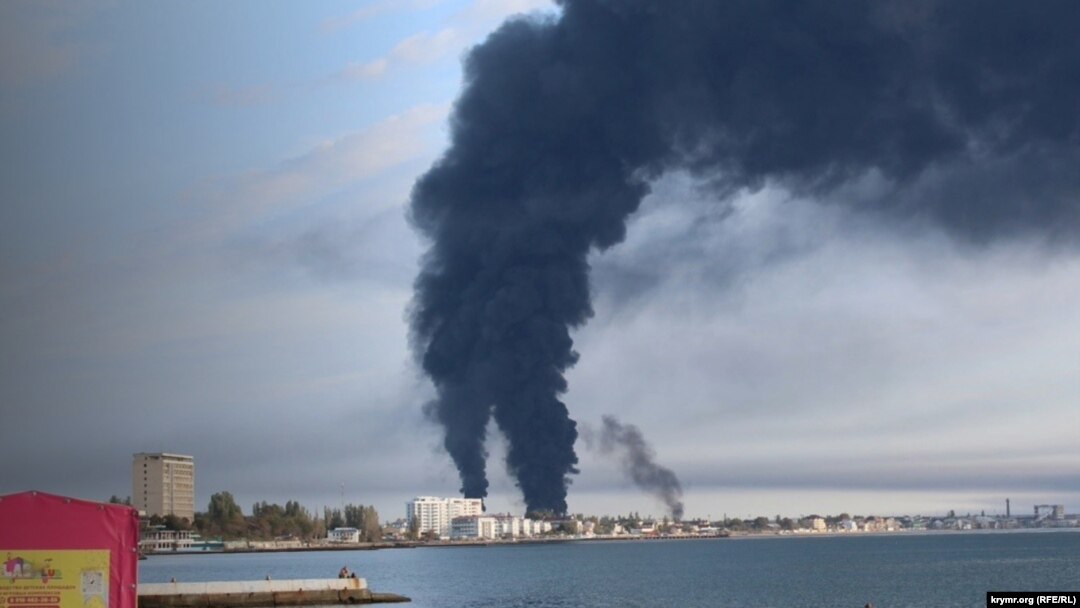A Ukrainian drone strike on the largest fuel depot in occupied Crimea early on October 7 triggered a huge fire that prompted the evacuation of hundreds of people as Russia and Ukraine exchanged another series of drone attacks.
Ukrainian Prime Minister Denys Shmyhal, meanwhile, opened a meeting with his Slovak counterpart, Robert Fico, who has voiced obstinate opposition to military aid for Kyiv since returning to power as relations between the two neighbors worsened.
The General Staff of the Ukrainian military claimed that its forces launched a successful strike on the fuel depot in the southeastern Crimean port city of Feodosia early on October 7.
The depot is the largest fuel storage facility in the occupied region that serves the occupying Russian military.
Russian Telegram channels said residents reported several powerful explosions that rang out in Feodosia around 4:30 a.m. local time (0030 GMT/UTC), after which a fire started.
Russian Telegram channel Astra posted a video purporting to show the fire, with local residents saying off-screen: "Such explosions! They did hit the oil depot after all." The footage shows a road sign for the village of Berehove, located near Feodosia.
SEE ALSO: Interactive Map: Occupied, Militarized CrimeaIgor Tkachenko, the Russian-installed chief of Crimea, confirmed that a fuel depot had caught fire, without mentioning a drone attack.
Oleg Kryuchkov, an adviser to Tkachenko, wrote on Telegram that there were no casualties.
About 300 people were evacuated from Feodosia, a city of some 70,000, Russian state news agency TASS reported, citing the authorities.
Russia's Defense Ministry, meanwhile, said on its Telegram channel that air defenses shot down 21 Ukrainian drones early on October 7 -- 12 over Crimea, six over the Kursk region, and the rest over the Belgorod, Bryansk, and Voronezh regions.
Ukraine, whose civilian and energy infrastructure has been battered relentlessly by Russian drone and missile strikes that have killed and wounded numerous civilians since the start of Moscow's unprovoked invasion in February 2022, has over the past year resorted in turn to striking military facilities inside Russia.
Ukrainian air defenses shot down 32 Russian drones and a Kinzhal cruise missile on October 7 over the Mykolayiv, Kyiv, Dnipropetrovsk, Sumy, Chernihiv, Poltava, and Kharkiv regions, the air force said on Telegram.
Meanwhile, Fico and Shmyhal started a meeting with talks ostensibly focusing on issues linked to oil and gas disputes but with Kyiv's overall battle against Russia’s full-scale invasion likely to dominate matters.
Earlier reports said the meeting was to be held in the Ukrainian border city of Uzhhorod, although no official confirmation came.
Since returning as prime minister of Slovakia a year ago, the populist Fico has dramatically altered the NATO and EU member's stance toward Ukraine, halting military aid, making a string of remarks that questioned Ukraine's sovereignty, and calling for peace with Russia.
Fico has also come out strongly against Ukraine potentially joining NATO.
"I think the question of Ukraine's NATO membership will be a decisive moment that will reveal a lot about NATO's future," he told Slovak TV at the site of a World War II battle near the northeastern Slovak village of Vysny Komarnik on October 6.
"This is something that I have openly told Prime Minister Shmyhal, the Americans, and everyone else: As long as I am Slovakia's prime minister, I will instruct the lawmakers who are under my political control as leader of the [Direction-Social Democracy] party that they never agree with Ukraine's NATO membership."


